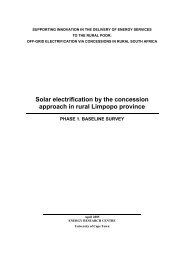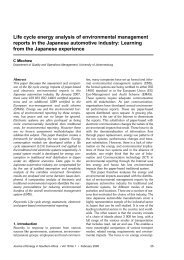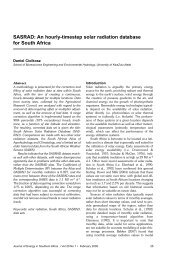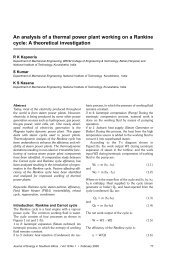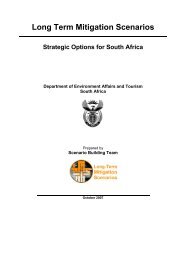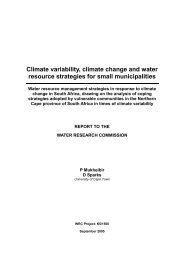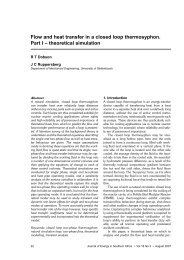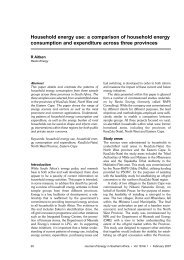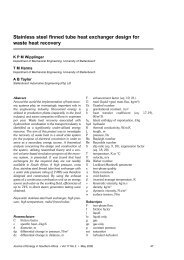Heat recovery in the textile dyeing and finishing industry ... - erc
Heat recovery in the textile dyeing and finishing industry ... - erc
Heat recovery in the textile dyeing and finishing industry ... - erc
Create successful ePaper yourself
Turn your PDF publications into a flip-book with our unique Google optimized e-Paper software.
Different scenarios <strong>in</strong> terms of tax regimes <strong>and</strong><br />
different models of <strong>the</strong> <strong>textile</strong> dye<strong>in</strong>g <strong>and</strong> f<strong>in</strong>ish<strong>in</strong>g<br />
<strong>in</strong>dustry were analysed. The overall results for<br />
three-year EM programmes <strong>in</strong> small <strong>and</strong> <strong>in</strong> large<br />
dye<strong>in</strong>g <strong>and</strong> f<strong>in</strong>ish<strong>in</strong>g plants were as follows:<br />
• The share of LPG levell<strong>in</strong>g at 3% of <strong>the</strong> fossil<br />
fuel consumption <strong>in</strong> dye<strong>in</strong>g <strong>and</strong> f<strong>in</strong>ish<strong>in</strong>g plants<br />
<strong>in</strong> 1995 should <strong>in</strong>crease to more than 10%. Coal<br />
usage estimated at 38% <strong>in</strong> 1995 should gradually<br />
decrease <strong>and</strong>, <strong>in</strong> <strong>the</strong> long term, be elim<strong>in</strong>ated.<br />
• Fossil fuel consumption should decrease by 15%<br />
<strong>in</strong> <strong>the</strong> first year <strong>and</strong> by ano<strong>the</strong>r 15% <strong>in</strong> <strong>the</strong> next<br />
two years for small plants. In large plants, <strong>the</strong><br />
correspond<strong>in</strong>g figures were 10% <strong>in</strong> <strong>the</strong> first year<br />
followed by a fur<strong>the</strong>r 10% <strong>in</strong> <strong>the</strong> next two years.<br />
• The above targets were possible through <strong>the</strong><br />
application of <strong>the</strong> follow<strong>in</strong>g listed <strong>in</strong> order of priority:<br />
i. Low-cost, energy-sav<strong>in</strong>g measures <strong>in</strong>clud<strong>in</strong>g<br />
waste heat <strong>recovery</strong> <strong>and</strong> reduction of<br />
live steam usage;<br />
ii. Planned ma<strong>in</strong>tenance, good housekeep<strong>in</strong>g<br />
as well as <strong>the</strong> education <strong>and</strong> tra<strong>in</strong><strong>in</strong>g of<br />
personnel;<br />
iii. LPG-related clean production technology,<br />
low-liquor ratio process<strong>in</strong>g <strong>and</strong> use of<br />
Information Technology (automation);<br />
iv.<br />
Recycl<strong>in</strong>g <strong>and</strong> <strong>recovery</strong> of energy, <strong>in</strong>clud<strong>in</strong>g<br />
waste water heat <strong>recovery</strong>;<br />
v. Solar heat<strong>in</strong>g <strong>and</strong> small-scale CHP.<br />
A low cost <strong>and</strong> practical solution was proposed<br />
to <strong>the</strong> problem of waste heat due to <strong>textile</strong> wastewater,<br />
<strong>the</strong> most important source of heat loss <strong>in</strong> <strong>the</strong><br />
dye<strong>in</strong>g <strong>and</strong> f<strong>in</strong>ish<strong>in</strong>g <strong>in</strong>dustry. The proposed heat<br />
<strong>recovery</strong> unit was made locally <strong>and</strong> was applicable<br />
to low-volume batch process<strong>in</strong>g, common <strong>in</strong> small<br />
plants. For each small dye<strong>in</strong>g <strong>and</strong> f<strong>in</strong>ish<strong>in</strong>g plant,<br />
<strong>the</strong> reduction <strong>in</strong> fossil fuel consumption could atta<strong>in</strong><br />
up to 10% with a payback period as low as 9<br />
months. The unit is illustrated <strong>in</strong> Figure 5.<br />
6. Conclusion<br />
• Techniques <strong>and</strong> technologies of implement<strong>in</strong>g<br />
Energy Management, <strong>in</strong>clud<strong>in</strong>g heat <strong>recovery</strong>, <strong>in</strong><br />
<strong>the</strong> use of steam <strong>in</strong> <strong>the</strong> <strong>textile</strong> <strong>in</strong>dustry vary<br />
extensively <strong>in</strong> terms of <strong>the</strong> scope of <strong>the</strong>ir application,<br />
<strong>the</strong>ir costs <strong>and</strong> <strong>the</strong>ir benefits. Energy<br />
Management takes <strong>the</strong> shape of a highly flexible<br />
tool with <strong>the</strong> capacity to <strong>in</strong>fluence <strong>the</strong> modernisation<br />
of <strong>in</strong>dustry <strong>in</strong> variable ways. With ris<strong>in</strong>g<br />
energy prices, Energy Management <strong>in</strong> <strong>in</strong>dustry<br />
is more urgent than ever as steam <strong>in</strong> most countries<br />
is <strong>in</strong>variably generated from imported fossil<br />
fuels.<br />
• The <strong>in</strong>troduction of low cost techniques <strong>and</strong><br />
technologies should yield significant reduction <strong>in</strong><br />
steam consumption <strong>in</strong> plants, where Energy<br />
Management has not been applied before. This<br />
is <strong>the</strong> case of many African countries where <strong>the</strong><br />
dye<strong>in</strong>g <strong>and</strong> f<strong>in</strong>ish<strong>in</strong>g <strong>in</strong>dustry is new, <strong>in</strong> some<br />
cases, even transposed from those <strong>in</strong> o<strong>the</strong>r<br />
countries.<br />
• Although, new technology is relatively expensive,<br />
its benefits extend far beyond sav<strong>in</strong>gs <strong>in</strong><br />
energy. Quality, productivity <strong>and</strong> response-time<br />
ga<strong>in</strong>s as well as environmental benefits are significant.<br />
If properly applied, <strong>the</strong> overall payback<br />
for <strong>in</strong>vestment <strong>in</strong> such technology can be<br />
reduced to not more than two years. However,<br />
<strong>in</strong>vest<strong>in</strong>g <strong>in</strong> such technology is not without risks<br />
particularly <strong>in</strong> view of <strong>the</strong> fact that <strong>the</strong>se are not<br />
<strong>in</strong>digenous to develop<strong>in</strong>g countries <strong>in</strong> almost all<br />
cases – know-how transfer <strong>and</strong> ancillary costs<br />
should be duly considered. The progress of such<br />
technology should also not be at <strong>the</strong> expense of<br />
<strong>in</strong>digenous techniques <strong>and</strong> technologies.<br />
• Mechanisms should be def<strong>in</strong>ed <strong>in</strong> order to facilitate<br />
<strong>the</strong> selective <strong>and</strong> timely <strong>in</strong>troduction of<br />
Energy Management techniques <strong>and</strong> technology.<br />
The needs of modernisation <strong>and</strong> of susta<strong>in</strong>able<br />
energy use for <strong>in</strong>dustry justify <strong>the</strong> <strong>in</strong>troduction<br />
of new <strong>in</strong>stitutional, regulatory <strong>and</strong> f<strong>in</strong>ancial<br />
measures. Develop<strong>in</strong>g countries can tap <strong>the</strong><br />
potential of heat <strong>recovery</strong> more easily if <strong>the</strong>re<br />
are such mechanisms. O<strong>the</strong>rwise, <strong>the</strong>re will be<br />
little <strong>in</strong>centive towards optimization of energy<br />
usage.<br />
• Examples from <strong>the</strong> past show that <strong>the</strong>re is significant<br />
scope to reduce production costs related<br />
Figure 5: Coil heat exchanger for heat <strong>recovery</strong> from waste water to process water<br />
14 Journal of Energy <strong>in</strong> Sou<strong>the</strong>rn Africa • Vol 21 No 3 • August 2010




